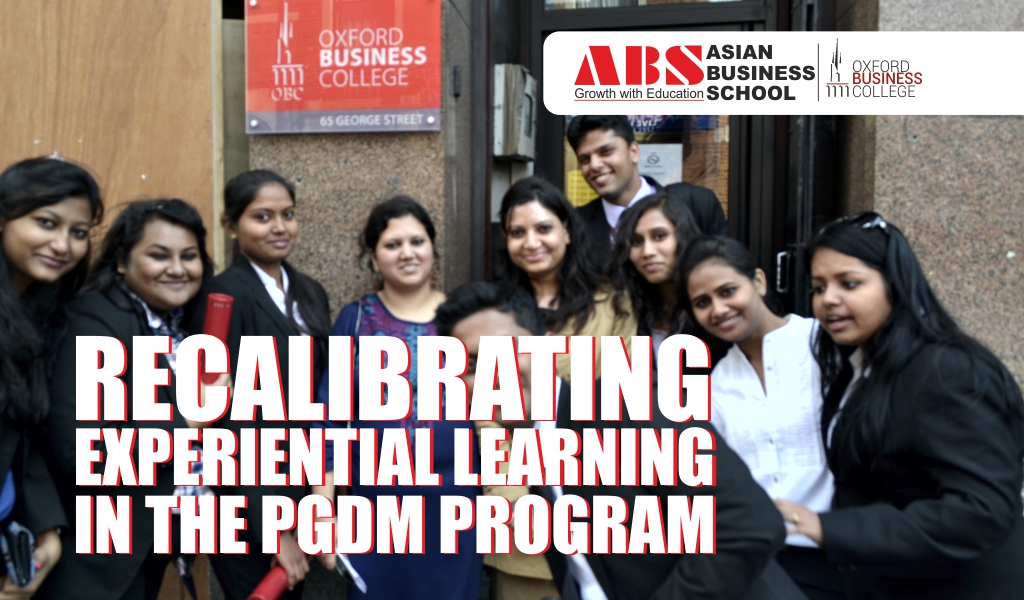Experiential learning is now part of a vast majority of full-time PGDM programs. In fact, according to a recent article, over 90% of full-time PGDM programs offer at least one project-based experiential learning course. Without doubt, this is a curriculum change that is being universally accepted across PGDM programs, and experiential learning is likely to become an integral part of all full-time PGDM programs, as well as an important mainstay in some.
Nonetheless, we must recognize that experiential learning is more than simply organizing opportunities for students to work with external clients. Indeed, experience by itself does not necessarily lead to learning; it is reflective inquiry on the experience that completes the learning. We must view any experience-based curricula through the lens of learning theory if we are to realize the full potential of “learning by doing.”
A possible reason we don’t see the structure of experiential learning curricula based on learning theory is that experiential learning in the PGDM traditionally has been driven by market forces and not by the internal business school initiatives to improve student learning. There are exceptions, of course—most notably, B-schools like the Asian Business School (ABS), Noida —that have practiced “action learning” right since its inception.
For most others, competition for the best students has necessitated business schools to address student needs, and students demanded ways to enhance their resumes. This development was especially relevant in one-year programs where there was no opportunity for internships. For instance, students with work experience in a single industry wanted to show “experience” in another industry, and students with little or no experience wanted to be able to demonstrate some experience. The experiential learning course was a convenient answer.
As such, with increasing competition for students, and the trend toward shorter programs, experiential learning is becoming a necessity in full-time PGDM programs. Be that as it may, experiential learning is often an ad-hoc course, rather than a carefully structured curriculum based on learning theory.
Tomorrow’s Business School & Experiential Learning
Experts suggest that experiential learning in business school curricula is only going to expand, not just because of student demand but also because of two other factors—both of which are driven by the fact that we live in a world of democratized information and ubiquitous knowledge.
First, in our information-laden world, learning by doing is often a better use of students’ (and teachers’) time than “learning by listening” in the classroom. Second, firms looking to hire PGDM graduates are less concerned about students carrying a head full of knowledge and more concerned about whether the students have learned to learn. That is to say that, have they developed the habit of continuous learning while on the job?
Considering the fact that experiential learning is growing in importance and becoming an integral part of the PGDM program, there is a definite need to think carefully about curriculum structure and the various learning outcomes from learning by doing.
Some business schools have already started in this direction; for example, the curriculum of Asian Business School is far ahead in comprehensively leveraging the value of experiential learning. Their PGDM curriculum carries a substantial percentage of experiential learning, or action learning, with immersive work experiences, multiple required projects, and sequenced residencies, all guided by learning theory. This integration of learning theory ensures that distinct learning outcomes are achieved.
Immersive Experiences
The projects are immersive residencies (every term) in host organizations, where students spend three to four weeks at the organization, delving into a business problem and helping to solve it. Every immersive residency is rich with opportunity for reflective inquiry beyond the team project. Thus, each student’s learning is not limited to just the project; their reflections produce additional learning, from a professional and personal standpoint that will vary depending on the student’s interests, past experiences, and future career aspirations.
Multiple Projects
The curriculum requires students to complete multiple experiential learning projects across the PGDM program. This approach provides more than just multiple occasions for learning by doing and collaborative teamwork; it affords the luxury of teaching students the habit of continuous learning, learning on the job, and the art of learning how to learn. Here, it may be noted that a habit of reflective inquiry will make sure that workplace learning is systematic, structured, and intentional, compared to workplace learning that is accidental or incidental.
Experiential learning is here to stay, and is expected to expand beyond the traditional “one elective” course in PGDM curricula. This trend is welcome, given that learning by doing is an effective way for long-term learning, and a way to help students learn how to learn on the job—an attribute that is increasingly valued by employers. However, it is important that the curriculum for experiential learning is not approached in an ad-hoc manner, but rather guided by learning theory, with a clear understanding of the learning outcomes desired.




